A Mixture of Summer Legume and Nonlegume Cover Crops Enhances Winter Wheat Yield, Nitrogen Uptake, and Nitrogen Balance
Abstract
1. Introduction
2. Materials and Methods
2.1. Field Site, Treatments, and Crop Management
2.2. Data Collections
2.3. Calculations
2.4. Data Analysis
3. Results
3.1. Monthly and Growing Season Precipitations
3.2. Cover Crop Biomass and Nitrogen Accumulation
3.3. Soil Mineral Nitrogen
3.4. Winter Wheat Aboveground Biomass and Grain Yields
3.5. Winter Wheat Seed Weight, Protein Concentration, and Harvest Index
3.6. Winter Wheat Aboveground Biomass and Grain Nitrogen Uptake
3.7. Winter Wheat Aboveground Biomass and Grain Nitrogen Productivity
3.8. Winter Wheat Aboveground Biomass and Grain Nitrogen Recovery Indices
3.9. Nitrogen Balance
4. Discussion
4.1. Cover Crop Biomass and Nitrogen Accumulation
4.2. Soil Mineral Nitrogen
4.3. Winter Wheat Yield, Harvest Index, Seed Weight, and Protein Concentration
4.4. Winter Wheat Aboveground Biomass and Grain Nitrogen Uptake
4.5. Winter Wheat Nitrogen Productivites and Recovery Indices
4.6. Nitrogen Balance
5. Conclusions
Author Contributions
Funding
Data Availability Statement
Acknowledgments
Conflicts of Interest
Abbreviations
References
- Poeplau, C.; Don, A. Carbon sequestration in agricultural soils via cultivation of cover crops—A meta-analysis. Agric. Ecosyst. Environ. 2015, 200, 33–41. [Google Scholar] [CrossRef]
- Dabney, S.M.; Delgado, J.A.; Reeves, D.W. Using winter cover crops to improve soil and water quality. Commun. Soil Sci. Plant Anal. 2001, 32, 1221–1250. [Google Scholar] [CrossRef]
- Di, H.J.; Cameron, K.C. Nitrate leaching in temperate agroecosystems: Sources, factors, and mitigating strategies. Nutr. Cycl. Agroecosyst. 2002, 64, 237–256. [Google Scholar] [CrossRef]
- Gabriel, J.L.; Almendros, P.; Hontoria, C.; Quemada, M. The role of cover crops in irrigated systems: Soil salinity and salt leaching. Agric. Ecosyst. Environ. 2012, 158, 200–207. [Google Scholar] [CrossRef]
- Damien, M.; Le Lann, C.; Desneux, N.; Alford, L.; Al Hassan, D.; Georges, R.; Van Baaren, J. Flowering cover crops in winter increase pest control but not trophic link diversity. Agric. Ecosyst. Environ. 2017, 247, 418–425. [Google Scholar] [CrossRef]
- Kaspar, T.C.; Singer, J.W. The use of cover crops to manage soil. In Soil Management: Building a Stable Base for Agriculture; Hatfield, J.L., Sauer, T.J., Eds.; Soil Science Society of America: Madison, WI, USA, 2011; pp. 321–337. [Google Scholar]
- Thorup-Kristensen, K.; Magid, J.; Jensen, L.S. Catch crops and green manures as biological tools in nitrogen management in temperate zones. Adv. Agron. 2003, 79, 227–302. [Google Scholar]
- Finney, D.M.; White, C.M.; Kaye, J.P. Biomass production and carbon/nitrogen ratio influence ecosystem services from cover crop mixtures. Agron. J. 2016, 108, 39–52. [Google Scholar] [CrossRef]
- Lüscher, A.; Mueller-Harvey, I.; Soussana, J.F.; Rees, R.M.; Peyraud, J.L. Potential of legume-based grassland–livestock systems in Europe: A review. Grass Forage Sci. 2014, 69, 206–228. [Google Scholar] [CrossRef]
- Abdalla, M.; Hastings, A.; Cheng, K.; Yue, Q.; Chadwick, D.; Espenberg, M.; Truu, J.; Rees, R.M.; Smith, P. A critical review of the impacts of cover crops on nitrogen leaching, net greenhouse gas balance and crop productivity. Glob. Change Biol. 2019, 25, 2530–2543. [Google Scholar] [CrossRef]
- Wells, M.S.; Reberg-Horton, S.C.; Smith, A.N.; Grossman, J.M. The reduction of plant-available nitrogen by cover crop mulches and subsequent effects on soybean performance and weed interference. Agron. J. 2013, 105, 539–545. [Google Scholar] [CrossRef]
- Muhammad, I.; Wang, J.; Sainju, U.M.; Zhang, S.H.; Zhao, F.Z.; Khan, A. Cover cropping enhances soil microbial biomass and affects microbial community structure: A meta-analysis. Geoderma 2021, 381, 114696. [Google Scholar] [CrossRef]
- Hauggaard-Nielsen, H.; Ambus, P.; Jensen, E.S. Interspecific competition, N use, and interference with weeds in pea–barley intercropping. Field Crops Res. 2001, 70, 101–109. [Google Scholar] [CrossRef]
- Sainju, U.M.; Singh, H.P.; Singh, B.P.; Whitehead, W.F.; Chiluwal, W.; Paudel, R. Soil carbon and nitrogen under bioenergy forage sorghum influenced by cover crop and nitrogen fertilization. Agrosyst. Geosci. Environ. 2018, 1, 180004. [Google Scholar] [CrossRef]
- Rasmussen, J.; Søegaard, K.; Pirhofer-Walzl, K.; Eriksen, J. N2-fixation and residual N effect of four legume species and four companion grass species. Eur. J. Agron. 2012, 36, 66–74. [Google Scholar] [CrossRef]
- Tosti, G.; Benincasa, P.; Farneselli, M.; Pace, R.; Tei, F.; Gaiducci, M.; Thorup-Kistensen, K. Green manuring effect of pure and mixed barley–hairy vetch winter cover crops on maize and processing tomato N nutrition. Eur. J. Agron. 2012, 43, 136–146. [Google Scholar] [CrossRef]
- Dahlin, A.S.; Stenberg, M.; Marstorp, H.; Mulch, N. Recycling in green manure leys under Scandinavian conditions. Nutr. Cycl. Agroecosyst. 2011, 91, 119–129. [Google Scholar] [CrossRef]
- Pandey, A.; Li, F.; Askegaard, M.; Rasmussen, I.A.; Olesen, J.E. Nitrogen balances in organic and conventional arable crop rotations and their relations to nitrogen yield and nitrate leaching losses. Agric. Eecosyst. Environ. 2018, 265, 350–362. [Google Scholar] [CrossRef]
- Holmes, A.A.; Thompson, A.A.; Lovell, S.T.; Villamil, M.B.; Yanarell, A.C.; Dawson, J.; Wortman, S.E. Nitrogen provisioned and recycled by cover crops in monoculture and mixture across two organic farms. Nutr. Cycl. Agroecosyst. 2019, 115, 441–453. [Google Scholar] [CrossRef]
- Clark, A.J.; Decker, A.M.; Meisinger, J.J. Seeding rate and kill date effects on hairy vetch-cereal rye cover crop mixtures for corn production. Agron. J. 1994, 86, 1065–1070. [Google Scholar] [CrossRef]
- Sainju, U.M.; Ghimire, R.; Pradhan, G.P. Improving dryland cropping system nitrogen balance with no-tillage and nitrogen fertilization. J. Plant Nutr. Soil Sci. 2019, 182, 374–384. [Google Scholar] [CrossRef]
- Sigdel, S.; Chatterjee, A. Do cover crop and soil-mediated legacy influence succeeding wheat production? Commun. Soil Sci. Plant Anal. 2020, 51, 1514–1524. [Google Scholar] [CrossRef]
- Miller, P.R.; McConkey, B.; Clayton, G.W.; Brandt, S.A.; Staricka, J.A.; Johnston, A.M.; Lafond, G.P.; Schatz, B.G.; Baltensperger, D.D.; Neill, K.E. Pulse crop adaptation in the northern Great Plains. Agron. J. 2002, 94, 261–272. [Google Scholar] [CrossRef]
- Singer, J.W.; Cox, W.J. Agronomics of corn production under different crop rotations in New York. J. Prod. Agric. 1998, 1, 462–468. [Google Scholar] [CrossRef]
- Allen, B.L.; Lenssen, A.W.; Sainju, U.M.; Jabro, J.D.; Stevens, W.B. Nitrogen use in spring wheat impacted by crop diversification, tillage, and management. Agron. J. 2021, 113, 2437–2439. [Google Scholar] [CrossRef]
- Sainju, U.M.; Lenssen, A.W.; Allen, B.L.; Jabro, J.D.; Stevens, W.B. Crop water and nitrogen productivity in response to diversified crop rotations and management systems. Agric. Water Manag. 2021, 257, 107149. [Google Scholar] [CrossRef]
- Sainju, U.M.; Lenssen, A.W.; Allen, B.L.; Stevens, W.B.; Jabro, J.D. Soil residual nitrogen under various crop rotations and cultural practices. J. Plant Nutr. Soil Sci. 2017, 180, 187–198. [Google Scholar] [CrossRef]
- Littell, R.C.; Milliken, G.A.; Stroup, W.W.; Wolfinger, R.D.; Schabenberger, O. SAS for Mixed Models, 2nd ed.; SAS Institute Inc.: Cary, NC, USA, 2006. [Google Scholar]
- Sainju, U.M.; Lenssen, A.W.; Allen, B.L.; Stevens, W.B.; Jabro, J.D. Nitrogen balance in response to dryland crop rotations and cultural practices. Agric. Ecosyst. Environ. 2016, 233, 25–32. [Google Scholar] [CrossRef]
- De Notaris, C.; Rasmussen, J.; Sørensen, P.; Melander, B.; Olesen, J.E. Manipulating cover crop growth by adjusting sowing time and cereal inter-row spacing to enhance residual nitrogen effects. Field Crops Res. 2019, 234, 15–25. [Google Scholar] [CrossRef]
- Pinto, P.; Rubio, G.; Gutierrez, F.; Sawchik, J.; Arana, S.; Pinero, G. Variable root: Shoot ratios and plant nitrogen concentrations discourage using just aboveground biomass to select legume service crops. Plant Soil 2021, 463, 347–358. [Google Scholar] [CrossRef]
- Russell, M.P.; Hargrove, W.L. Cropping systems: Ecology and management. In Nitrogen Management and Groundwater Protection; Follett, R.F., Ed.; Elsevier Science Publication Company: New York, NY, USA, 1989; pp. 277–317. [Google Scholar]
- Ranells, N.N.; Wagger, M.G. Nitrogen release from grass and legume cover crop monocultures and bicultures. Agron. J. 1996, 88, 777–782. [Google Scholar] [CrossRef]
- Kuo, S.; Sainju, U.M.; Jellum, E.J. Winter cover cropping influence on nitrogen in soil. Soil Sci. Soc. Am. J. 1997, 61, 1392–1399. [Google Scholar] [CrossRef]
- Crandall, S.M.; Ruffo, M.L.; Bollero, G.A. Cropping system and nitrogen dynamics under a cereal winter cover crop preceding corn. Plant Soil 2005, 268, 209–219. [Google Scholar] [CrossRef]
- Brozovic, B.; Jug, D.; Jug, I.; Durdevic, B.; Vukadinovic, V.; Tadic, V.; Stipesevic, B. Influence of winter cover crops incorporation on weed infestation in popcorn maize (Zea mays everta Sturt.) organic production. Agric. Conspec. Sci. 2018, 83, 77–81. [Google Scholar]
- Lenssen, A.W.; Sainju, U.M.; Jabro, J.D.; Iversen, W.M.; Allen, B.L.; Evans, R.G. Crop diversification, tillage, and management system influence spring wheat yield and water use. Agron. J. 2014, 106, 1445–1454. [Google Scholar] [CrossRef]
- Osmond, D.L.; Riha, S.J. Nitrogen fertilizer requirements for maize produced in the tropics: A comparison of three computer-based recommendation systems. Agric. Syst. 1996, 50, 37–50. [Google Scholar] [CrossRef]
- Geleto, T.; Tanner, D.G.; Mamo, T.; Gebeyehu, G. Response of rainfed bread and durum wheat to source, level, and timing of nitrogen fertilizer on two Ethiopian Vertisols: II. N uptake, recovery and efficiency. Fertil. Res. 1996, 44, 195–204. [Google Scholar] [CrossRef]
- López-Bellido, R.J.; Castillo, J.E.; López-Bellido, L. Comparative response of bread and durum wheat cultivars to nitrogen fertilizer in a rainfed Mediterranean environment: Soil nitrate and N uptake and efficiency. Nutr. Cycl. Agroecosyst. 2008, 80, 121–130. [Google Scholar] [CrossRef]
- Zhang, D.B.; Yao, P.W.; Zhao, N.; Changwei, Y.; Weidong, C.; Gao, Y. Contribution of green manure legumes to nitrogen dynamics in traditional winter wheat cropping system in the Loess Plateau of China. Eur. J. Agron. 2016, 72, 47–55. [Google Scholar]
- Eickhout, B.; Bouwman, A.P.; van Zeijts, H. The role of nitrogen in world food production and environmental sustainability. Agric. Ecosyst. Environ. 2006, 116, 4–14. [Google Scholar] [CrossRef]
- Ross, S.M.; Izaurralde, R.C.; Janzen, H.H.; Robertson, J.A.; McGill, W.B. The nitrogen balance of three long-term agroecosystems on a boreal soil in western Canada. Agric. Ecosyst. Environ. 2008, 127, 241–250. [Google Scholar] [CrossRef]
- Lupawi, N.Z.; Soon, Y.K. Nitrogen-related rotational effects of legume crops on three consecutive subsequent crops. Soil Sci. Soc. Am. J. 2016, 80, 306–316. [Google Scholar] [CrossRef]
- Wang, J.; Sainju, U.M.; Zhang, S.; Raza, M.A. Soil mineral nitrogen and winter wheat nitrogen productivity influenced by summer cover crop and nitrogen fertilization. J. Plant Nutr. 2024. [Google Scholar] [CrossRef]
- Sainju, U.M.; Ghimire, R.; Wang, J. Relating soil organic carbon fractions to crop yield and quality with cover crops. In Soil Organic Matter and Feeding the Future; Lal, R., Ed.; Taylor and Francis: Boca Raton, FL, USA, 2022; pp. 65–90. [Google Scholar]
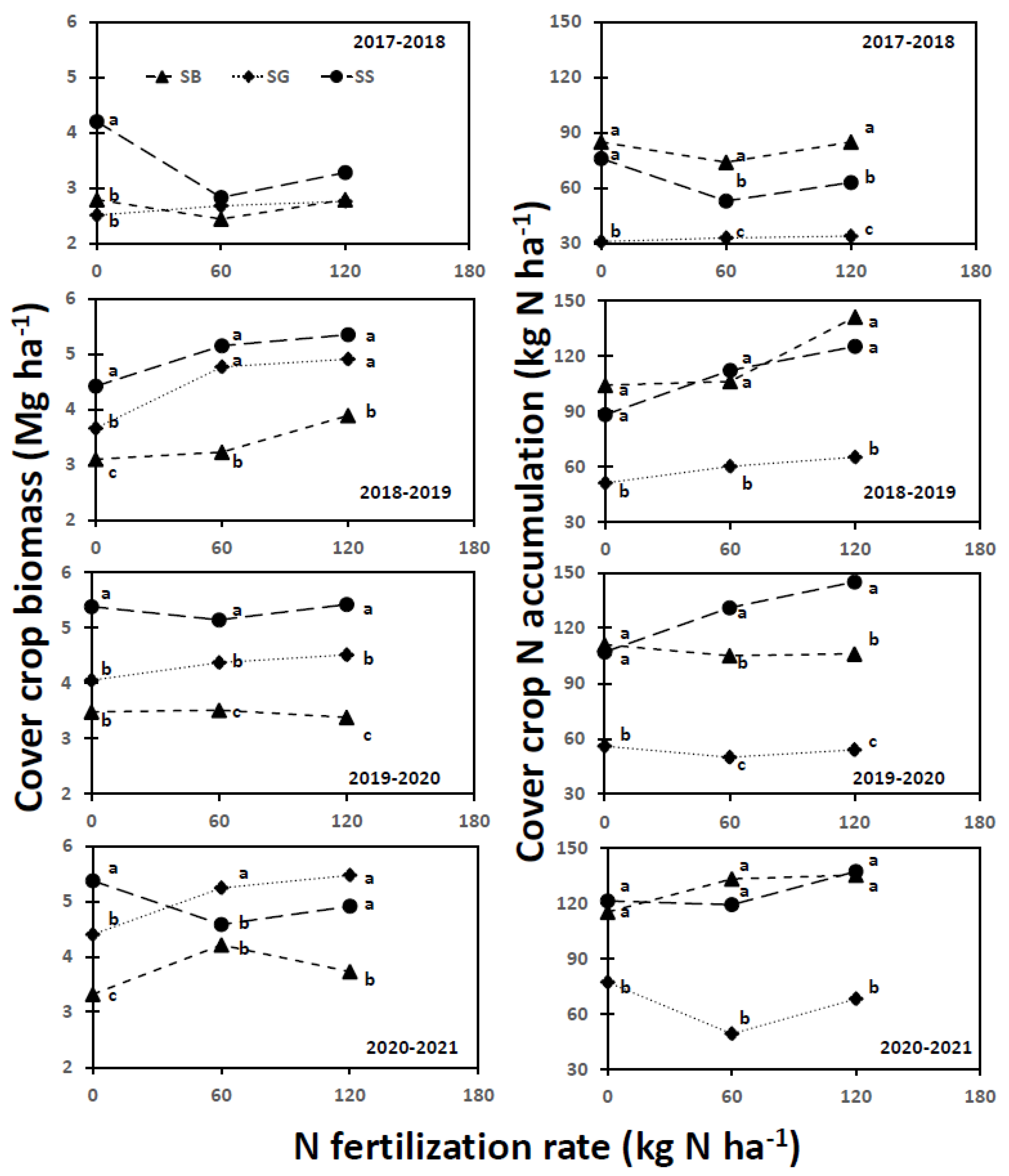
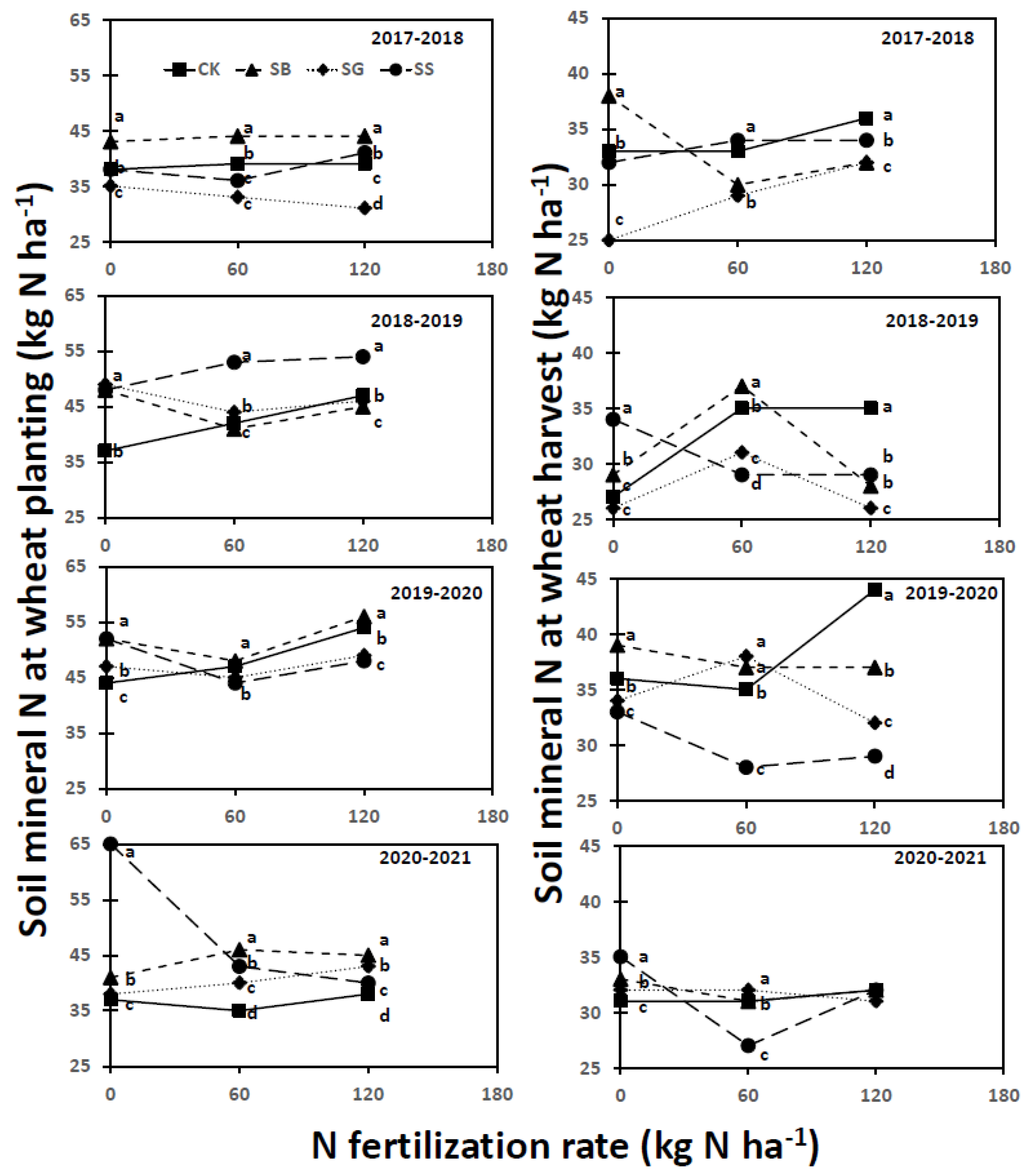

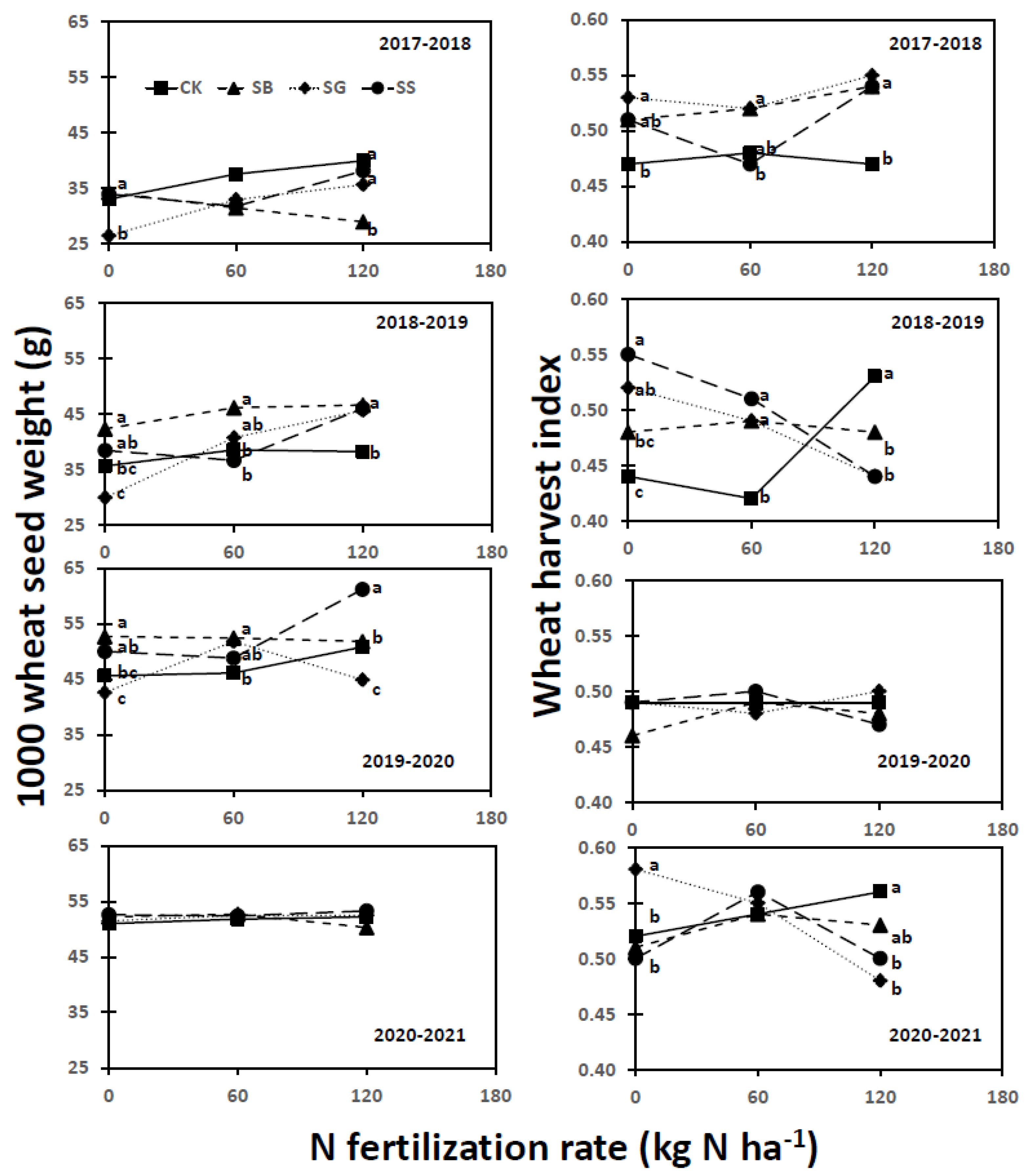
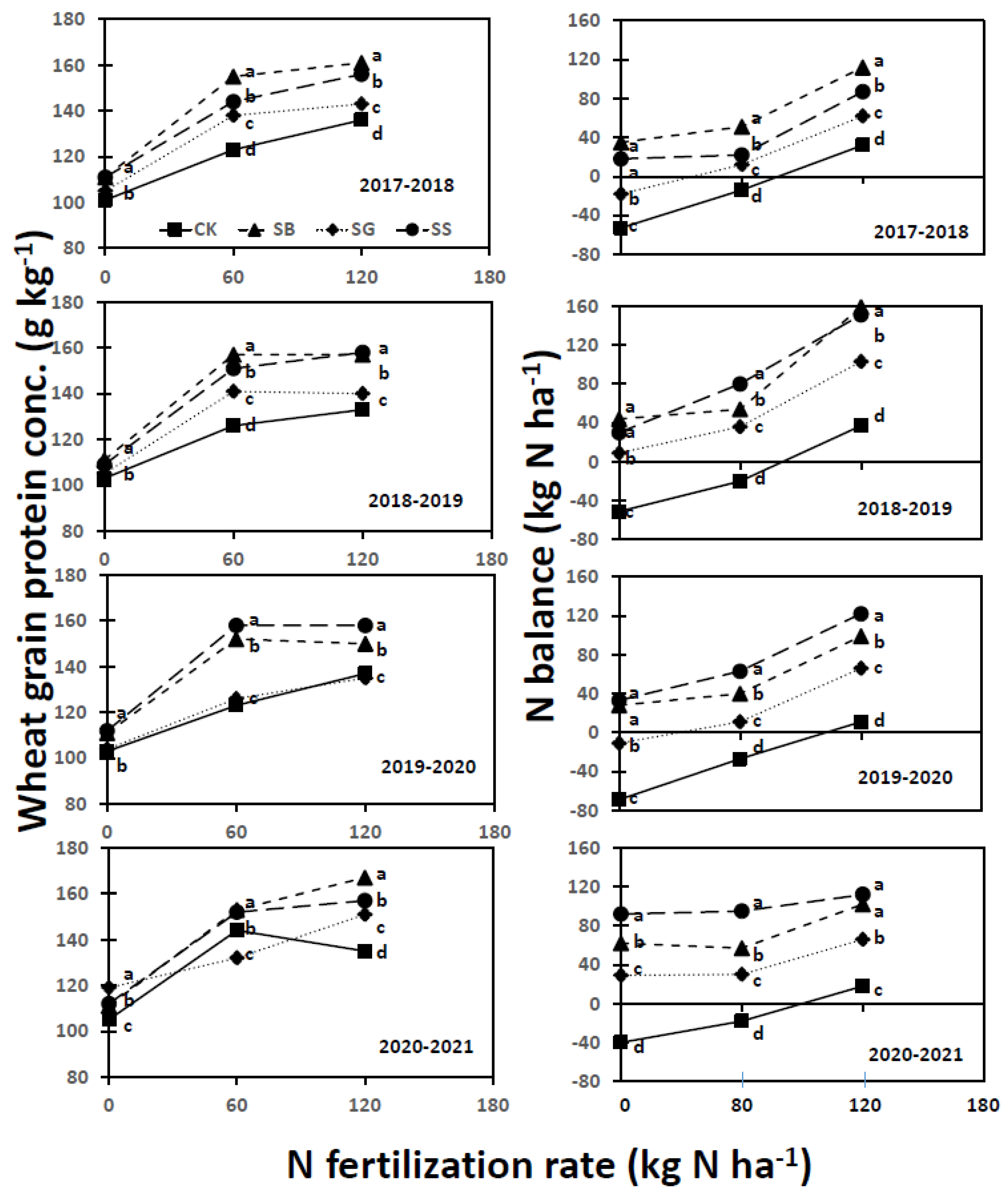
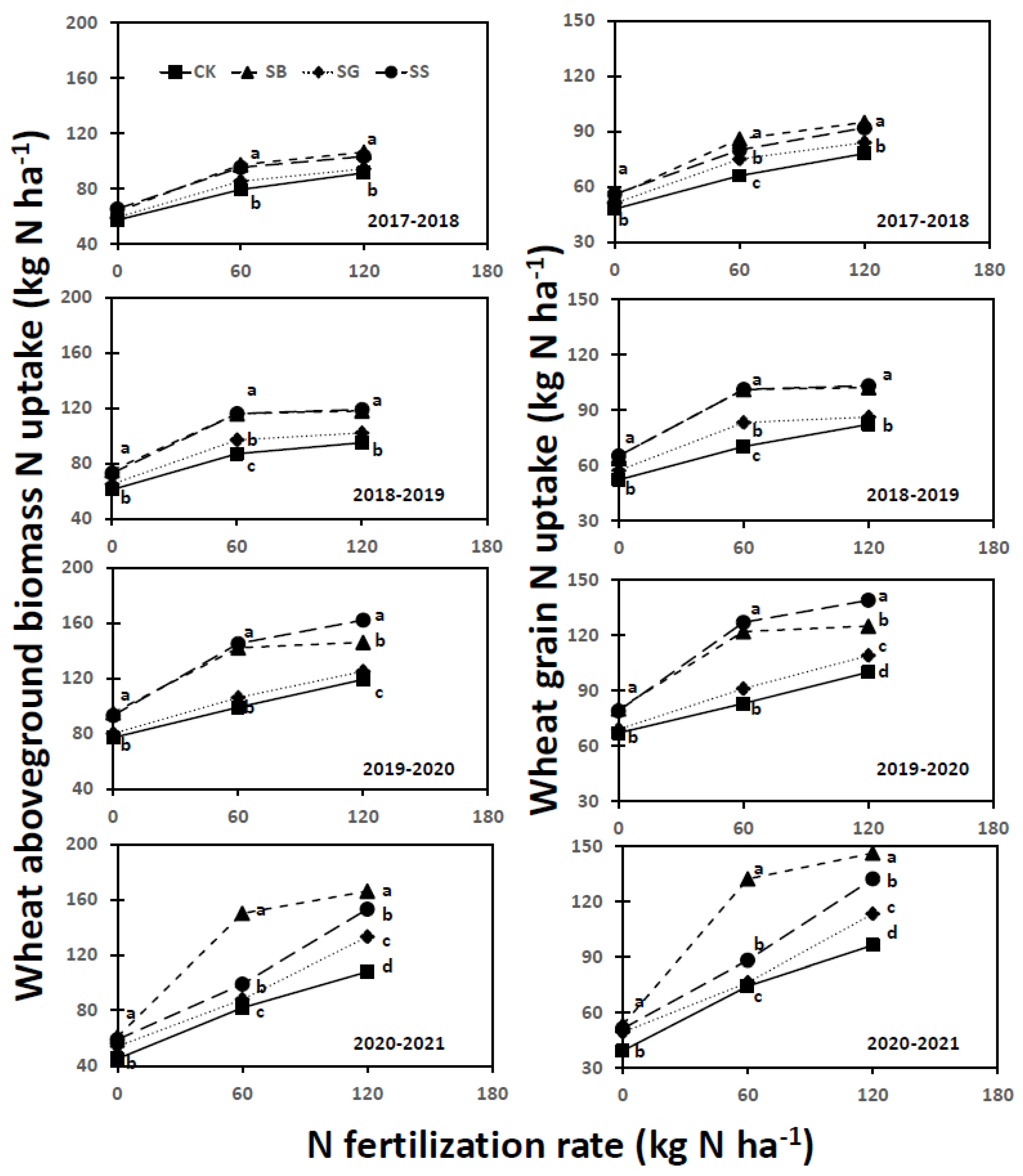

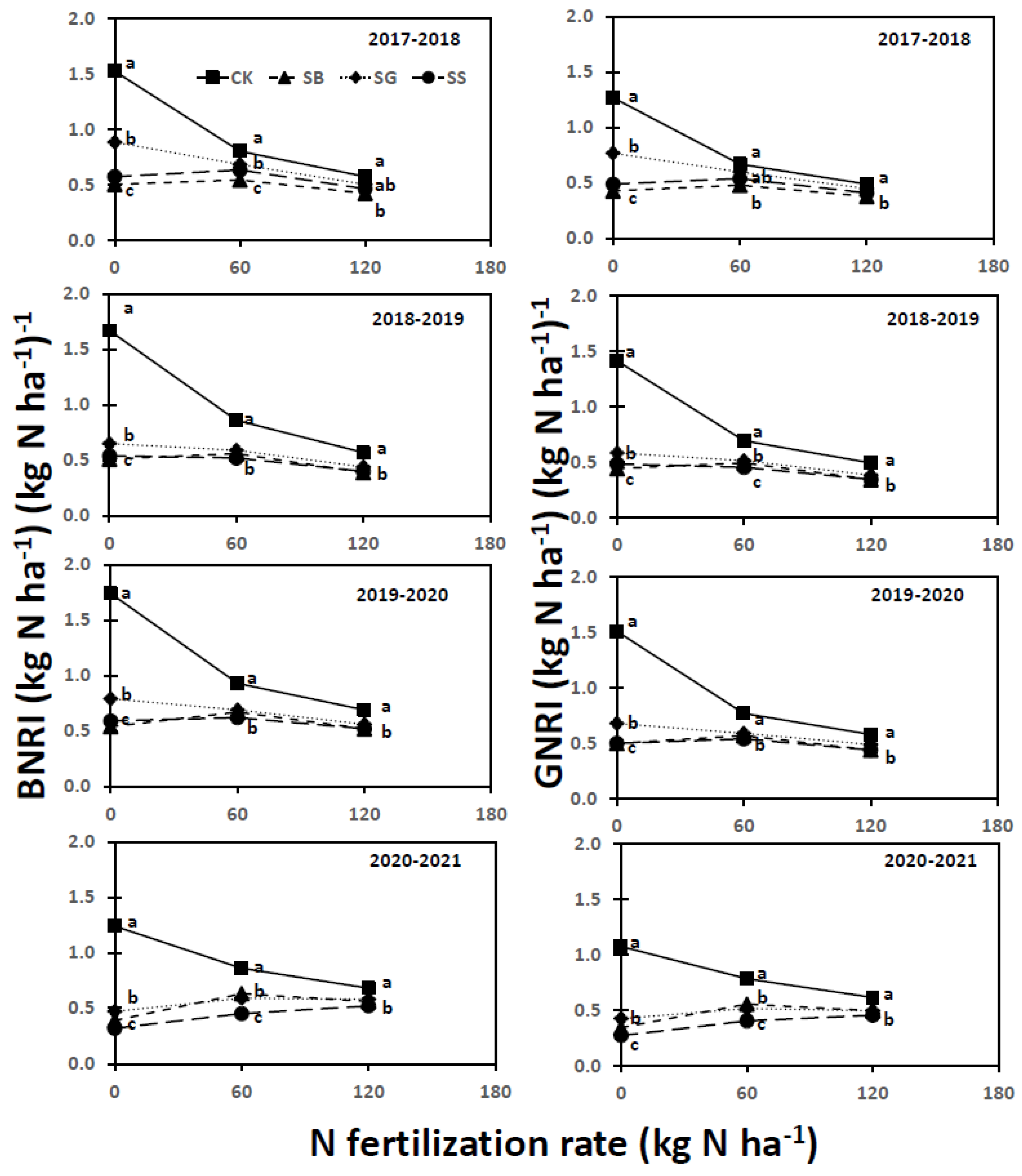
| Month | Precipitation (mm) | ||||
|---|---|---|---|---|---|
| 2017–2018 | 2018–2019 | 2019–2020 | 2020–2021 | 30-Year Average | |
| July | 41 | 192 | 191 | 88 | 105 |
| August | 149 | 105 | 92 | 145 | 116 |
| September | 27 | 75 | 119 | 33 | 91 |
| October | 93 | 13 | 80 | 46 | 49 |
| November | 1 | 9 | 21 | 21 | 17 |
| December | 0 | 0 | 3 | 3 | 5 |
| January | 19 | 0 | 7 | 1 | 8 |
| February | 4 | 10 | 14 | 15 | 11 |
| March | 22 | 4 | 4 | 28 | 23 |
| April | 41 | 50 | 7 | 76 | 36 |
| May | 45 | 66 | 44 | 48 | 53 |
| June | 107 | 63 | 131 | 110 | 70 |
| Cover crop growing season (July–September) | 218 | 372 | 401 | 266 | 312 |
| Wheat growing season (October–June) | 331 | 214 | 311 | 349 | 272 |
| Total (July–June) | 549 | 586 | 713 | 615 | 584 |
| Source | CCB | CCBN | SMNP | SMNH | AB | GY | SW | HI |
|---|---|---|---|---|---|---|---|---|
| p Values | ||||||||
| C | <0.001 | <0.001 | <0.001 | <0.001 | <0.001 | <0.001 | 0.003 | 0.073 |
| N | <0.001 | <0.001 | <0.001 | <0.001 | <0.001 | <0.001 | <0.001 | 0.863 |
| C × N | <0.001 | 0.065 | <0.001 | <0.001 | <0.001 | <0.001 | <0.001 | 0.002 |
| Y | <0.001 | <0.001 | <0.001 | <0.001 | <0.001 | <0.001 | <0.001 | <0.001 |
| C × Y | <0.001 | <0.001 | <0.001 | <0.001 | <0.001 | <0.001 | <0.001 | 0.008 |
| N × Y | <0.001 | <0.001 | <0.001 | <0.001 | <0.001 | <0.001 | 0.096 | 0.018 |
| C × N × Y | <0.001 | <0.001 | <0.001 | <0.001 | <0.001 | <0.001 | 0.016 | <0.001 |
| Source | PC | BNU | GNU | BNP | GNP | BNRI | GNRI | NB |
|---|---|---|---|---|---|---|---|---|
| p Values | ||||||||
| C | <0.001 | <0.001 | <0.001 | <0.001 | <0.001 | <0.001 | <0.001 | <0.001 |
| N | <0.001 | <0.001 | <0.001 | <0.001 | <0.001 | <0.001 | <0.001 | <0.001 |
| C × N | <0.001 | <0.001 | <0.001 | <0.001 | <0.001 | <0.001 | <0.001 | <0.001 |
| Y | <0.001 | <0.001 | <0.001 | <0.001 | <0.001 | <0.001 | <0.001 | <0.001 |
| C × Y | <0.001 | <0.001 | <0.001 | <0.001 | <0.001 | <0.001 | <0.001 | <0.001 |
| N × Y | 0.003 | <0.001 | 0.001 | <0.001 | <0.001 | <0.001 | <0.001 | <0.001 |
| C × N × Y | <0.001 | <0.001 | <0.001 | <0.001 | <0.001 | <0.001 | <0.001 | 0.003 |
Disclaimer/Publisher’s Note: The statements, opinions and data contained in all publications are solely those of the individual author(s) and contributor(s) and not of MDPI and/or the editor(s). MDPI and/or the editor(s) disclaim responsibility for any injury to people or property resulting from any ideas, methods, instructions or products referred to in the content. |
© 2024 by the authors. Licensee MDPI, Basel, Switzerland. This article is an open access article distributed under the terms and conditions of the Creative Commons Attribution (CC BY) license (https://creativecommons.org/licenses/by/4.0/).
Share and Cite
Wang, J.; Sainju, U.M.; Zhang, S. A Mixture of Summer Legume and Nonlegume Cover Crops Enhances Winter Wheat Yield, Nitrogen Uptake, and Nitrogen Balance. Nitrogen 2024, 5, 871-890. https://doi.org/10.3390/nitrogen5040056
Wang J, Sainju UM, Zhang S. A Mixture of Summer Legume and Nonlegume Cover Crops Enhances Winter Wheat Yield, Nitrogen Uptake, and Nitrogen Balance. Nitrogen. 2024; 5(4):871-890. https://doi.org/10.3390/nitrogen5040056
Chicago/Turabian StyleWang, Jun, Upendra M. Sainju, and Shaohong Zhang. 2024. "A Mixture of Summer Legume and Nonlegume Cover Crops Enhances Winter Wheat Yield, Nitrogen Uptake, and Nitrogen Balance" Nitrogen 5, no. 4: 871-890. https://doi.org/10.3390/nitrogen5040056
APA StyleWang, J., Sainju, U. M., & Zhang, S. (2024). A Mixture of Summer Legume and Nonlegume Cover Crops Enhances Winter Wheat Yield, Nitrogen Uptake, and Nitrogen Balance. Nitrogen, 5(4), 871-890. https://doi.org/10.3390/nitrogen5040056








